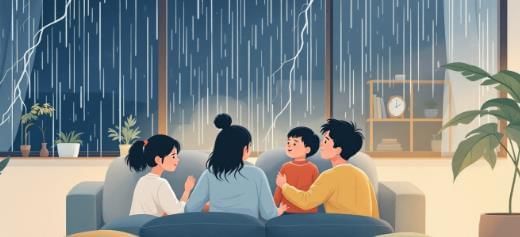Case Based Questions: Pressure, Winds, Storms, and Cyclones | Science Curiosity Class 8 - New NCERT PDF Download
Q1: Read the source below and answer the questions that follow:
Amara and her friends were enjoying a picnic on a hilltop. Suddenly, strong gusts of wind started blowing, lifting napkins and light objects into the air. They noticed how quickly the wind could move things around and realised how powerful air can be during such weather.
(a) Why did the napkins fly away on a windy day? (1 mark)
(b) How does air pressure change when wind speed increases? (2 marks)
(c) What safety precautions should Amara and her friends take if the wind becomes stormy? (1 mark)
Ans:
(a) The wind exerts force on the napkins, lifting and pushing them away.
(b) When wind speed increases, air pressure in that region decreases, creating low-pressure areas.
(c) They should move to a safe shelter away from trees and open spaces.
Q2: Read the source below and answer the questions that follow:
Ravi set up two fountains in his garden with water jets at different heights. He observed that the water from the taller fountain shot higher and faster than the lower one. He became curious about how the height of water affects pressure and flow.
(a) How does height affect water pressure in Ravi’s fountains? (1 mark)
(b) Why does the water flow faster from the higher nozzle? (2 marks)
(c) How does this principle apply to overhead water tanks in buildings? (1 mark)
Ans:
(a) Water pressure increases with increasing height of the water column.
(b) Higher pressure at the base pushes water out with more force and speed.
(c) Overhead tanks use gravity to create pressure for the water supply.
Q3: Read the source below and answer the questions that follow:
During her visit to the beach, Meera felt a cool breeze blowing from the sea toward the land while the sun shone brightly. She wondered why the wind direction changed during the day and noticed that the land became hotter than the sea.
(a) Why does the wind blow from the sea towards the land during the day? (2 marks)
(b) What causes the low-pressure area over the land? (1 mark)
(c) How would the direction of the wind change at night? (1 mark)
Ans:
(a) The land heats up faster than the sea, causing air to rise and creating low pressure over land; cooler air from the sea moves in.
(b) Warm air rising due to heating causes low pressure.
(c) At night, land cools faster, so wind blows from land to sea (land breeze).
Q4: Read the source below and answer the questions that follow:
Sanjay rubbed a balloon on his sweater to generate static electricity. He then brought it close to scattered paper pieces, which suddenly jumped toward the balloon. He was amazed at how rubbing the balloon could create invisible forces acting at a distance.
(a) What force causes the paper pieces to stick to the balloon? (1 mark)
(b) Why is this force called a non-contact force? (1 mark)
(c) Explain what happens to charges during rubbing. (2 marks)
Ans:
(a) Static (electrostatic) force attracts the paper pieces to the balloon after rubbing.
(b) It’s a non-contact force because the balloon attracts paper without touching it.
(c) Rubbing transfers electrons, charging the balloon negatively and causing attraction.
Q5: Read the source below and answer the questions that follow:
Arjun was gazing at the sky when dark clouds gathered quickly. Within minutes, lightning and thunder appeared as a storm developed. He noticed the speed and power of storms and wondered what caused such sudden weather changes.
(a) What causes the formation of storm clouds? (2 marks)
(b) Why are storms often accompanied by thunder and lightning? (2 marks)
(c) What should Arjun do to stay safe during a thunderstorm? (1 mark)
Ans:
(a) Warm moist air rises, cools, and condenses, forming storm clouds.
(b) Charges build inside clouds from friction, creating lightning; thunder occurs due to rapid air expansion.
(c) During storms, stay indoors, away from tall objects and water, and avoid using electrical devices.
Q6: Read the source below and answer the questions that follow:
Residents of a coastal town had just one day to prepare as a cyclone formed over the nearby ocean. They noticed strong winds, heavy rain, and rising sea waves approaching. People realised how warm water and weather conditions could combine to create powerful storms.
(a) How does warm ocean water lead to cyclone formation? (2 marks)
(b) Why do cyclones spin instead of moving straight? (1 mark)
(c) Why does cyclone intensity reduce after it moves inland? (1 mark)
Ans:
(a) Warm ocean water heats air, causing it to rise and create low pressure, drawing more air and forming a cyclone.
(b) Earth’s rotation causes the cyclone to spin (Coriolis effect).
(c) Over land, lack of warm moist air and friction reduces cyclone strength.
Q7: Read the source below and answer the questions that follow:
During a heavy storm, Sanjay noticed the wind shaking the windows and doors of his house. Objects outside flew around, and the pressure on the roof seemed stronger. He realised how important it was to secure homes during such events.
(a) How do high-speed winds cause pressure differences on and inside houses? (2 marks)
(b) Why is it safer to keep doors and windows open during such winds? (1 mark)
(c) What damage can strong winds cause in urban areas? (1 mark)
Ans:
(a) Fast wind lowers air pressure above roofs, while higher pressure inside pushes upward, risking roof damage.
(b) Opening doors and windows reduces pressure difference, helping protect homes.
(c) Strong winds can cause structural damage, fallen trees, power failure, and flying debris.
Q8: Read the source below and answer the questions that follow:
Raj took two blocks of the same size but made of different materials and dropped them into water. He observed which floated and which sank, learning how material density affects buoyancy.
(a) Which block will float better on water and why? (2 marks)
(b) How does displacement of water relate to buoyancy? (1 mark)
(c) What happens when the weight of displaced water equals the object’s weight? (1 mark)
Ans:
(a) Cork floats better because it’s less dense than water; wood is denser and less buoyant.
(b) Buoyant force equals the weight of fluid displaced by the object.
(c) Objects float when the buoyant force equals their weight.
Q9: Read the source below and answer the questions that follow:
A thunderstorm warning was issued in Neha’s city, with lightning and strong winds expected. Residents prepared by staying indoors and avoiding dangerous outdoor areas. Neha observed how lightning forms and why safety precautions are crucial.
(a) Why does lightning occur during thunderstorms? (1 mark)
(b) What are some precautions that should be taken during lightning? (2 marks)
(c) Why is it safer inside a car or building during lightning? (1 mark)
Ans:
(a) Lightning is the discharge of static electricity built up in clouds.
(b) Stay indoors, avoid water, metal objects, tall trees, and electrical appliances.
(c) Cars and buildings act as protective enclosures, preventing harm by directing lightning safely.
Q10: Read the source below and answer the questions that follow:
While flying in a flight, Tina felt pressure changes in her ears during ascent and descent. She noticed discomfort and “popping” sensations, prompting her to understand how air pressure changes with altitude.
(a) How does air pressure change with altitude? (1 mark)
(b) Why do ears “pop” during ascent or descent? (2 marks)
(c) How does the body equalise pressure changes? (1 mark)
Ans:
(a) Air pressure decreases as altitude increases.
(b) Pressure difference between inside and outside the ear causes discomfort; popping equalises pressure.
(c) Swallowing or yawning opens the Eustachian tube, balancing pressures.
|
59 videos|236 docs|13 tests
|
FAQs on Case Based Questions: Pressure, Winds, Storms, and Cyclones - Science Curiosity Class 8 - New NCERT
| 1. What is the difference between pressure and wind in the context of weather phenomena? |  |
| 2. How do storms form, and what are the main types of storms? |  |
| 3. What are cyclones, and how do they differ from other storm systems? |  |
| 4. What is the role of the Coriolis effect in the formation of winds and storms? |  |
| 5. How are pressure systems measured and what significance do they have in predicting weather? |  |
















